Nepal Earthquake's Impact on Tourism
VerifiedAdded on 2019/12/03
|18
|4779
|248
Report
AI Summary
This research proposal investigates the significant impact of the 2015 Nepal earthquake on the country's tourism industry. It explores the earthquake's devastating effects on tourism infrastructure, economic losses, and the subsequent decline in tourist arrivals. The proposal outlines a research methodology that includes both qualitative and quantitative data collection methods, such as questionnaires and literature reviews, to assess the extent of the damage and identify effective rebuilding strategies. The study aims to provide insights into the long-term revival of Nepal's tourism sector, offering recommendations for public authorities and private businesses to mitigate future risks and promote sustainable tourism development. The timeline for the research is three years, encompassing literature review, data collection, analysis, and report writing.
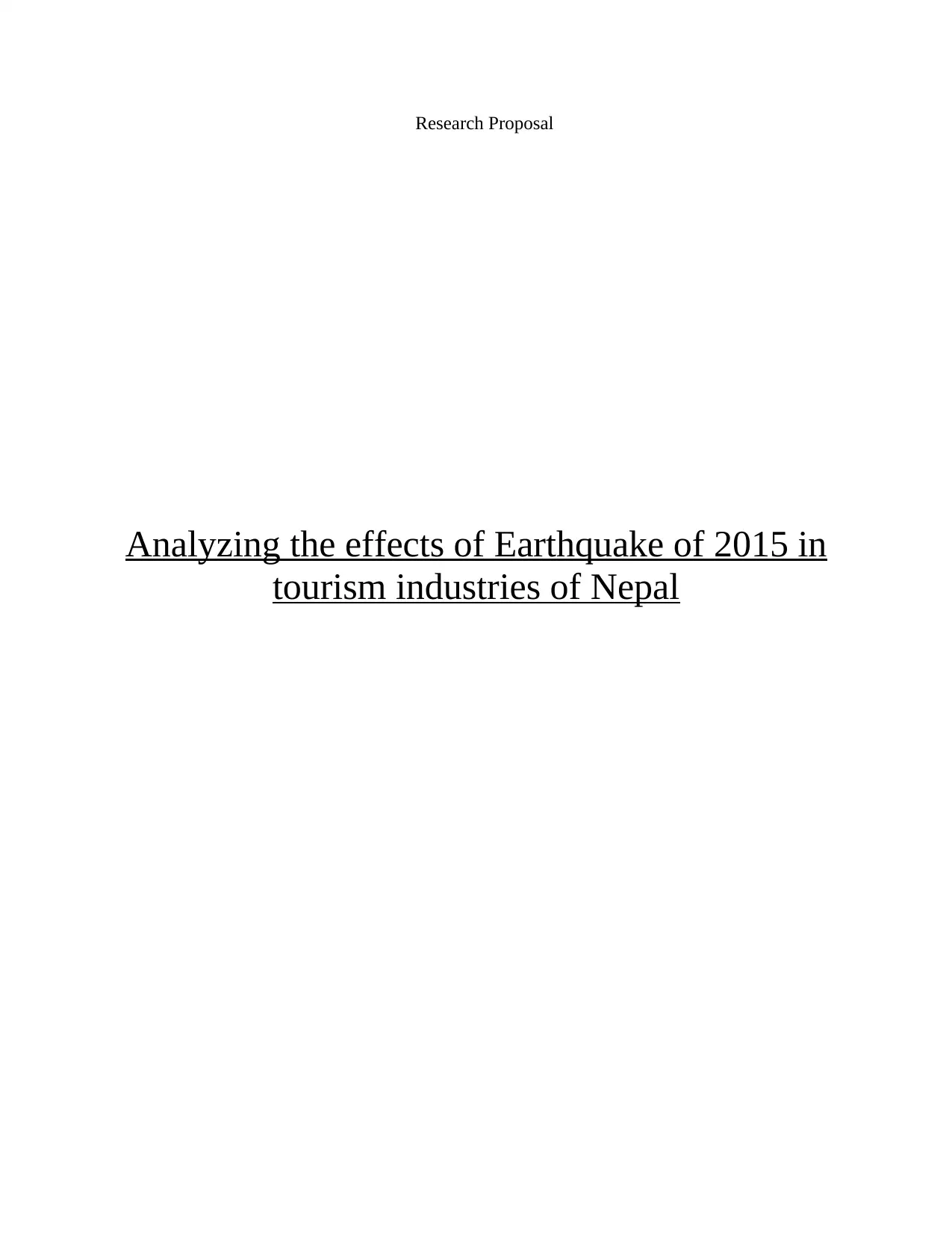
Research Proposal
Analyzing the effects of Earthquake of 2015 in
tourism industries of Nepal
Analyzing the effects of Earthquake of 2015 in
tourism industries of Nepal
Paraphrase This Document
Need a fresh take? Get an instant paraphrase of this document with our AI Paraphraser
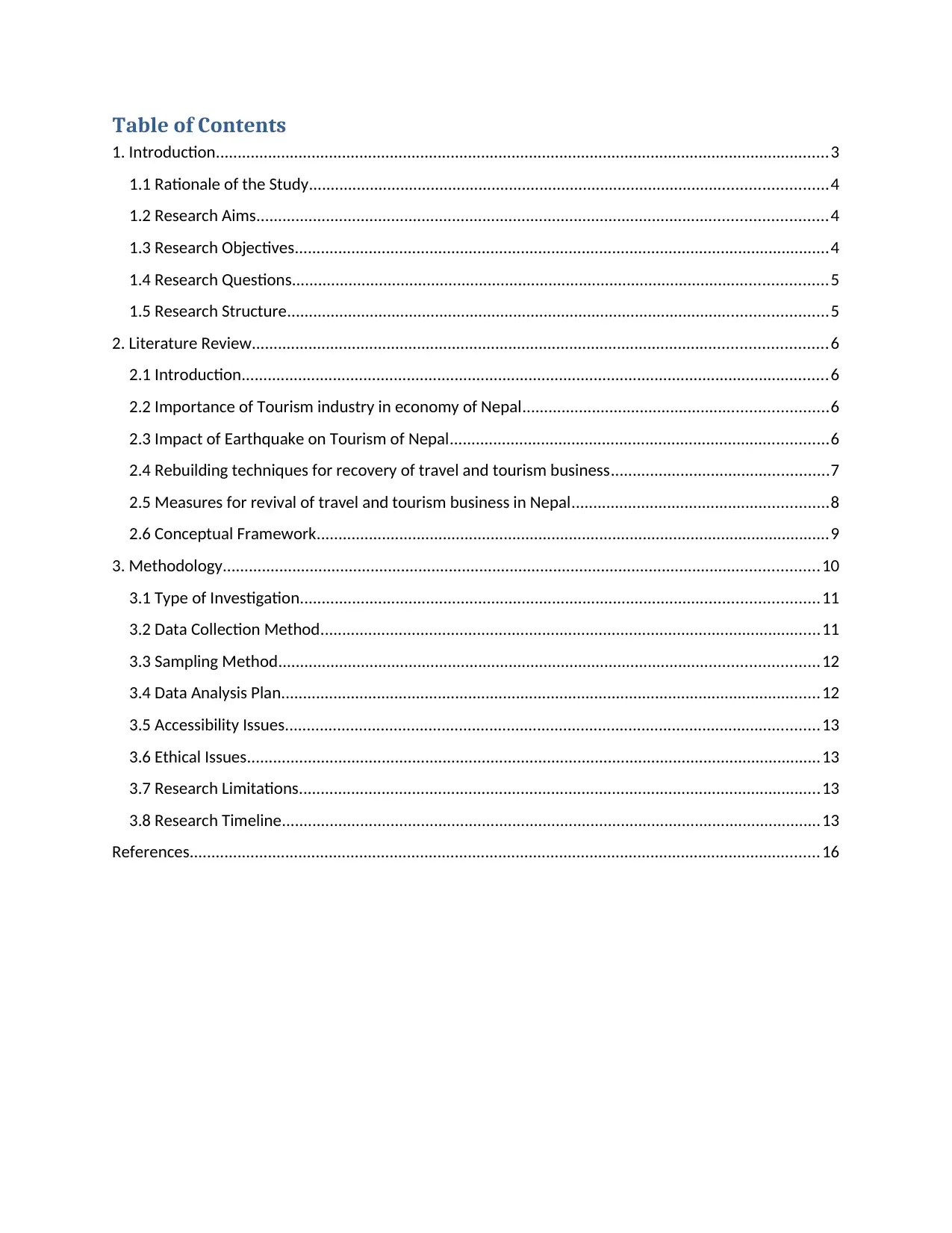
Table of Contents
1. Introduction.............................................................................................................................................3
1.1 Rationale of the Study.......................................................................................................................4
1.2 Research Aims...................................................................................................................................4
1.3 Research Objectives...........................................................................................................................4
1.4 Research Questions...........................................................................................................................5
1.5 Research Structure............................................................................................................................5
2. Literature Review....................................................................................................................................6
2.1 Introduction.......................................................................................................................................6
2.2 Importance of Tourism industry in economy of Nepal......................................................................6
2.3 Impact of Earthquake on Tourism of Nepal.......................................................................................6
2.4 Rebuilding techniques for recovery of travel and tourism business..................................................7
2.5 Measures for revival of travel and tourism business in Nepal...........................................................8
2.6 Conceptual Framework......................................................................................................................9
3. Methodology.........................................................................................................................................10
3.1 Type of Investigation.......................................................................................................................11
3.2 Data Collection Method...................................................................................................................11
3.3 Sampling Method............................................................................................................................12
3.4 Data Analysis Plan............................................................................................................................12
3.5 Accessibility Issues...........................................................................................................................13
3.6 Ethical Issues....................................................................................................................................13
3.7 Research Limitations........................................................................................................................13
3.8 Research Timeline............................................................................................................................13
References.................................................................................................................................................16
1. Introduction.............................................................................................................................................3
1.1 Rationale of the Study.......................................................................................................................4
1.2 Research Aims...................................................................................................................................4
1.3 Research Objectives...........................................................................................................................4
1.4 Research Questions...........................................................................................................................5
1.5 Research Structure............................................................................................................................5
2. Literature Review....................................................................................................................................6
2.1 Introduction.......................................................................................................................................6
2.2 Importance of Tourism industry in economy of Nepal......................................................................6
2.3 Impact of Earthquake on Tourism of Nepal.......................................................................................6
2.4 Rebuilding techniques for recovery of travel and tourism business..................................................7
2.5 Measures for revival of travel and tourism business in Nepal...........................................................8
2.6 Conceptual Framework......................................................................................................................9
3. Methodology.........................................................................................................................................10
3.1 Type of Investigation.......................................................................................................................11
3.2 Data Collection Method...................................................................................................................11
3.3 Sampling Method............................................................................................................................12
3.4 Data Analysis Plan............................................................................................................................12
3.5 Accessibility Issues...........................................................................................................................13
3.6 Ethical Issues....................................................................................................................................13
3.7 Research Limitations........................................................................................................................13
3.8 Research Timeline............................................................................................................................13
References.................................................................................................................................................16
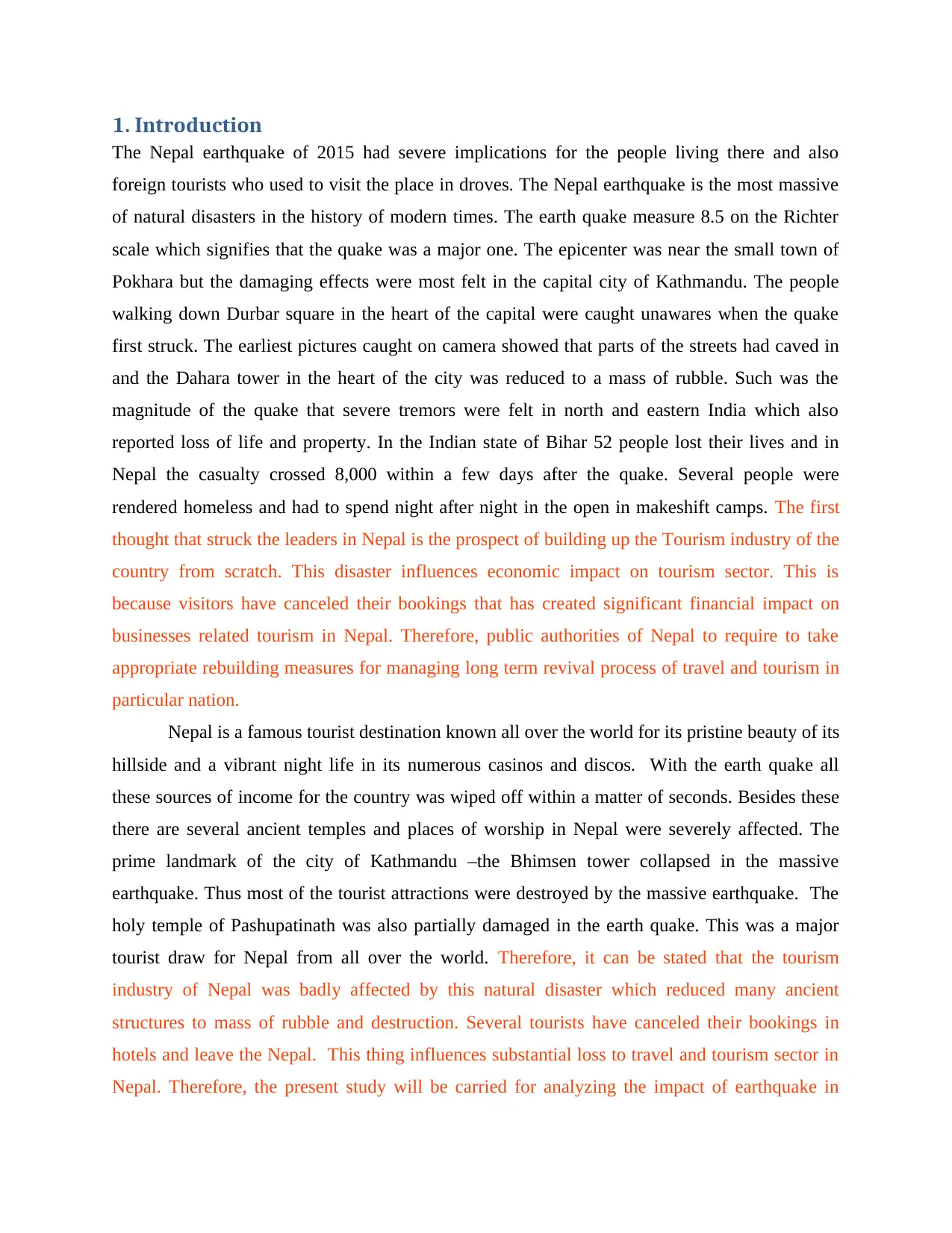
1. Introduction
The Nepal earthquake of 2015 had severe implications for the people living there and also
foreign tourists who used to visit the place in droves. The Nepal earthquake is the most massive
of natural disasters in the history of modern times. The earth quake measure 8.5 on the Richter
scale which signifies that the quake was a major one. The epicenter was near the small town of
Pokhara but the damaging effects were most felt in the capital city of Kathmandu. The people
walking down Durbar square in the heart of the capital were caught unawares when the quake
first struck. The earliest pictures caught on camera showed that parts of the streets had caved in
and the Dahara tower in the heart of the city was reduced to a mass of rubble. Such was the
magnitude of the quake that severe tremors were felt in north and eastern India which also
reported loss of life and property. In the Indian state of Bihar 52 people lost their lives and in
Nepal the casualty crossed 8,000 within a few days after the quake. Several people were
rendered homeless and had to spend night after night in the open in makeshift camps. The first
thought that struck the leaders in Nepal is the prospect of building up the Tourism industry of the
country from scratch. This disaster influences economic impact on tourism sector. This is
because visitors have canceled their bookings that has created significant financial impact on
businesses related tourism in Nepal. Therefore, public authorities of Nepal to require to take
appropriate rebuilding measures for managing long term revival process of travel and tourism in
particular nation.
Nepal is a famous tourist destination known all over the world for its pristine beauty of its
hillside and a vibrant night life in its numerous casinos and discos. With the earth quake all
these sources of income for the country was wiped off within a matter of seconds. Besides these
there are several ancient temples and places of worship in Nepal were severely affected. The
prime landmark of the city of Kathmandu –the Bhimsen tower collapsed in the massive
earthquake. Thus most of the tourist attractions were destroyed by the massive earthquake. The
holy temple of Pashupatinath was also partially damaged in the earth quake. This was a major
tourist draw for Nepal from all over the world. Therefore, it can be stated that the tourism
industry of Nepal was badly affected by this natural disaster which reduced many ancient
structures to mass of rubble and destruction. Several tourists have canceled their bookings in
hotels and leave the Nepal. This thing influences substantial loss to travel and tourism sector in
Nepal. Therefore, the present study will be carried for analyzing the impact of earthquake in
The Nepal earthquake of 2015 had severe implications for the people living there and also
foreign tourists who used to visit the place in droves. The Nepal earthquake is the most massive
of natural disasters in the history of modern times. The earth quake measure 8.5 on the Richter
scale which signifies that the quake was a major one. The epicenter was near the small town of
Pokhara but the damaging effects were most felt in the capital city of Kathmandu. The people
walking down Durbar square in the heart of the capital were caught unawares when the quake
first struck. The earliest pictures caught on camera showed that parts of the streets had caved in
and the Dahara tower in the heart of the city was reduced to a mass of rubble. Such was the
magnitude of the quake that severe tremors were felt in north and eastern India which also
reported loss of life and property. In the Indian state of Bihar 52 people lost their lives and in
Nepal the casualty crossed 8,000 within a few days after the quake. Several people were
rendered homeless and had to spend night after night in the open in makeshift camps. The first
thought that struck the leaders in Nepal is the prospect of building up the Tourism industry of the
country from scratch. This disaster influences economic impact on tourism sector. This is
because visitors have canceled their bookings that has created significant financial impact on
businesses related tourism in Nepal. Therefore, public authorities of Nepal to require to take
appropriate rebuilding measures for managing long term revival process of travel and tourism in
particular nation.
Nepal is a famous tourist destination known all over the world for its pristine beauty of its
hillside and a vibrant night life in its numerous casinos and discos. With the earth quake all
these sources of income for the country was wiped off within a matter of seconds. Besides these
there are several ancient temples and places of worship in Nepal were severely affected. The
prime landmark of the city of Kathmandu –the Bhimsen tower collapsed in the massive
earthquake. Thus most of the tourist attractions were destroyed by the massive earthquake. The
holy temple of Pashupatinath was also partially damaged in the earth quake. This was a major
tourist draw for Nepal from all over the world. Therefore, it can be stated that the tourism
industry of Nepal was badly affected by this natural disaster which reduced many ancient
structures to mass of rubble and destruction. Several tourists have canceled their bookings in
hotels and leave the Nepal. This thing influences substantial loss to travel and tourism sector in
Nepal. Therefore, the present study will be carried for analyzing the impact of earthquake in
⊘ This is a preview!⊘
Do you want full access?
Subscribe today to unlock all pages.

Trusted by 1+ million students worldwide
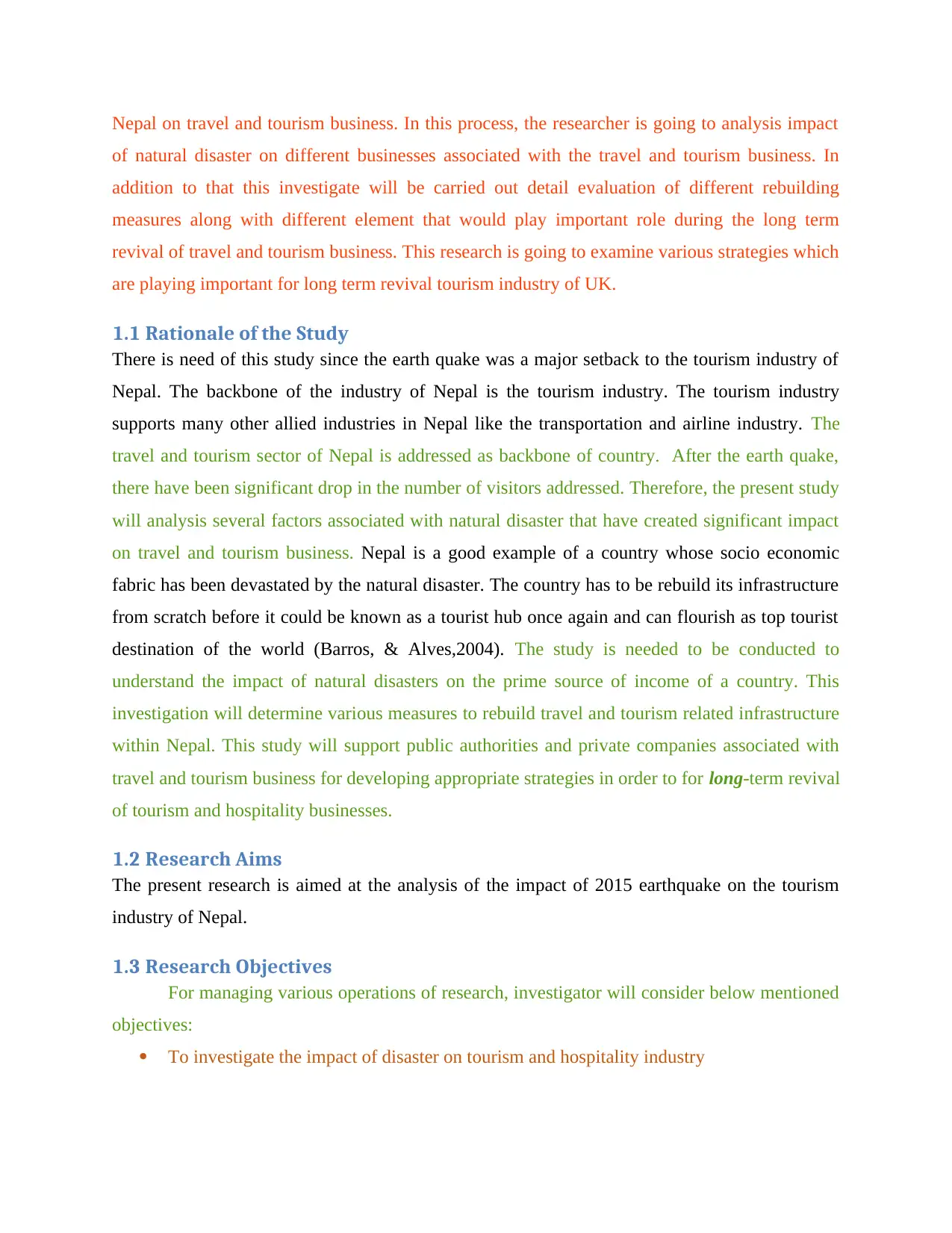
Nepal on travel and tourism business. In this process, the researcher is going to analysis impact
of natural disaster on different businesses associated with the travel and tourism business. In
addition to that this investigate will be carried out detail evaluation of different rebuilding
measures along with different element that would play important role during the long term
revival of travel and tourism business. This research is going to examine various strategies which
are playing important for long term revival tourism industry of UK.
1.1 Rationale of the Study
There is need of this study since the earth quake was a major setback to the tourism industry of
Nepal. The backbone of the industry of Nepal is the tourism industry. The tourism industry
supports many other allied industries in Nepal like the transportation and airline industry. The
travel and tourism sector of Nepal is addressed as backbone of country. After the earth quake,
there have been significant drop in the number of visitors addressed. Therefore, the present study
will analysis several factors associated with natural disaster that have created significant impact
on travel and tourism business. Nepal is a good example of a country whose socio economic
fabric has been devastated by the natural disaster. The country has to be rebuild its infrastructure
from scratch before it could be known as a tourist hub once again and can flourish as top tourist
destination of the world (Barros, & Alves,2004). The study is needed to be conducted to
understand the impact of natural disasters on the prime source of income of a country. This
investigation will determine various measures to rebuild travel and tourism related infrastructure
within Nepal. This study will support public authorities and private companies associated with
travel and tourism business for developing appropriate strategies in order to for long-term revival
of tourism and hospitality businesses.
1.2 Research Aims
The present research is aimed at the analysis of the impact of 2015 earthquake on the tourism
industry of Nepal.
1.3 Research Objectives
For managing various operations of research, investigator will consider below mentioned
objectives:
To investigate the impact of disaster on tourism and hospitality industry
of natural disaster on different businesses associated with the travel and tourism business. In
addition to that this investigate will be carried out detail evaluation of different rebuilding
measures along with different element that would play important role during the long term
revival of travel and tourism business. This research is going to examine various strategies which
are playing important for long term revival tourism industry of UK.
1.1 Rationale of the Study
There is need of this study since the earth quake was a major setback to the tourism industry of
Nepal. The backbone of the industry of Nepal is the tourism industry. The tourism industry
supports many other allied industries in Nepal like the transportation and airline industry. The
travel and tourism sector of Nepal is addressed as backbone of country. After the earth quake,
there have been significant drop in the number of visitors addressed. Therefore, the present study
will analysis several factors associated with natural disaster that have created significant impact
on travel and tourism business. Nepal is a good example of a country whose socio economic
fabric has been devastated by the natural disaster. The country has to be rebuild its infrastructure
from scratch before it could be known as a tourist hub once again and can flourish as top tourist
destination of the world (Barros, & Alves,2004). The study is needed to be conducted to
understand the impact of natural disasters on the prime source of income of a country. This
investigation will determine various measures to rebuild travel and tourism related infrastructure
within Nepal. This study will support public authorities and private companies associated with
travel and tourism business for developing appropriate strategies in order to for long-term revival
of tourism and hospitality businesses.
1.2 Research Aims
The present research is aimed at the analysis of the impact of 2015 earthquake on the tourism
industry of Nepal.
1.3 Research Objectives
For managing various operations of research, investigator will consider below mentioned
objectives:
To investigate the impact of disaster on tourism and hospitality industry
Paraphrase This Document
Need a fresh take? Get an instant paraphrase of this document with our AI Paraphraser
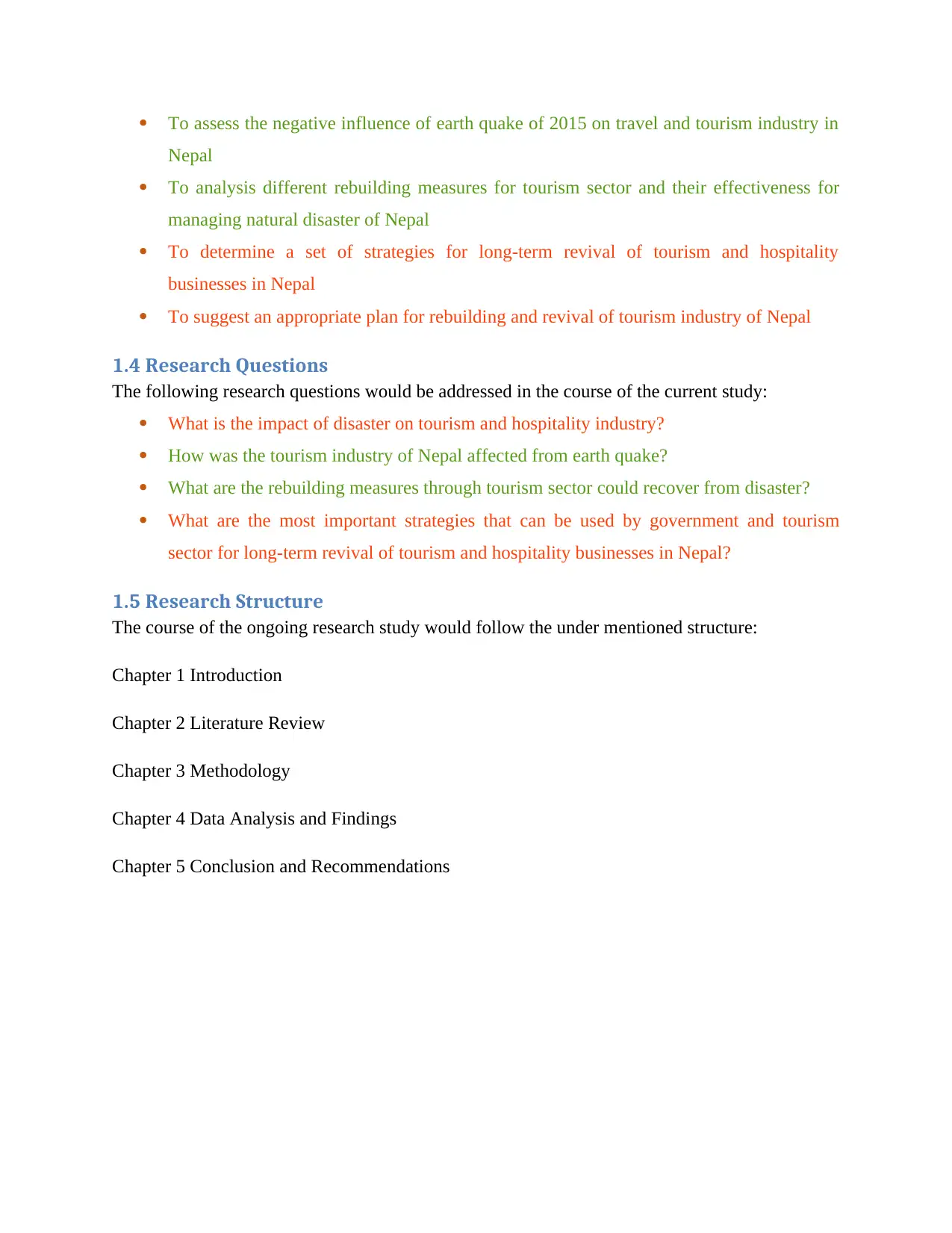
To assess the negative influence of earth quake of 2015 on travel and tourism industry in
Nepal
To analysis different rebuilding measures for tourism sector and their effectiveness for
managing natural disaster of Nepal
To determine a set of strategies for long-term revival of tourism and hospitality
businesses in Nepal
To suggest an appropriate plan for rebuilding and revival of tourism industry of Nepal
1.4 Research Questions
The following research questions would be addressed in the course of the current study:
What is the impact of disaster on tourism and hospitality industry?
How was the tourism industry of Nepal affected from earth quake?
What are the rebuilding measures through tourism sector could recover from disaster?
What are the most important strategies that can be used by government and tourism
sector for long-term revival of tourism and hospitality businesses in Nepal?
1.5 Research Structure
The course of the ongoing research study would follow the under mentioned structure:
Chapter 1 Introduction
Chapter 2 Literature Review
Chapter 3 Methodology
Chapter 4 Data Analysis and Findings
Chapter 5 Conclusion and Recommendations
Nepal
To analysis different rebuilding measures for tourism sector and their effectiveness for
managing natural disaster of Nepal
To determine a set of strategies for long-term revival of tourism and hospitality
businesses in Nepal
To suggest an appropriate plan for rebuilding and revival of tourism industry of Nepal
1.4 Research Questions
The following research questions would be addressed in the course of the current study:
What is the impact of disaster on tourism and hospitality industry?
How was the tourism industry of Nepal affected from earth quake?
What are the rebuilding measures through tourism sector could recover from disaster?
What are the most important strategies that can be used by government and tourism
sector for long-term revival of tourism and hospitality businesses in Nepal?
1.5 Research Structure
The course of the ongoing research study would follow the under mentioned structure:
Chapter 1 Introduction
Chapter 2 Literature Review
Chapter 3 Methodology
Chapter 4 Data Analysis and Findings
Chapter 5 Conclusion and Recommendations
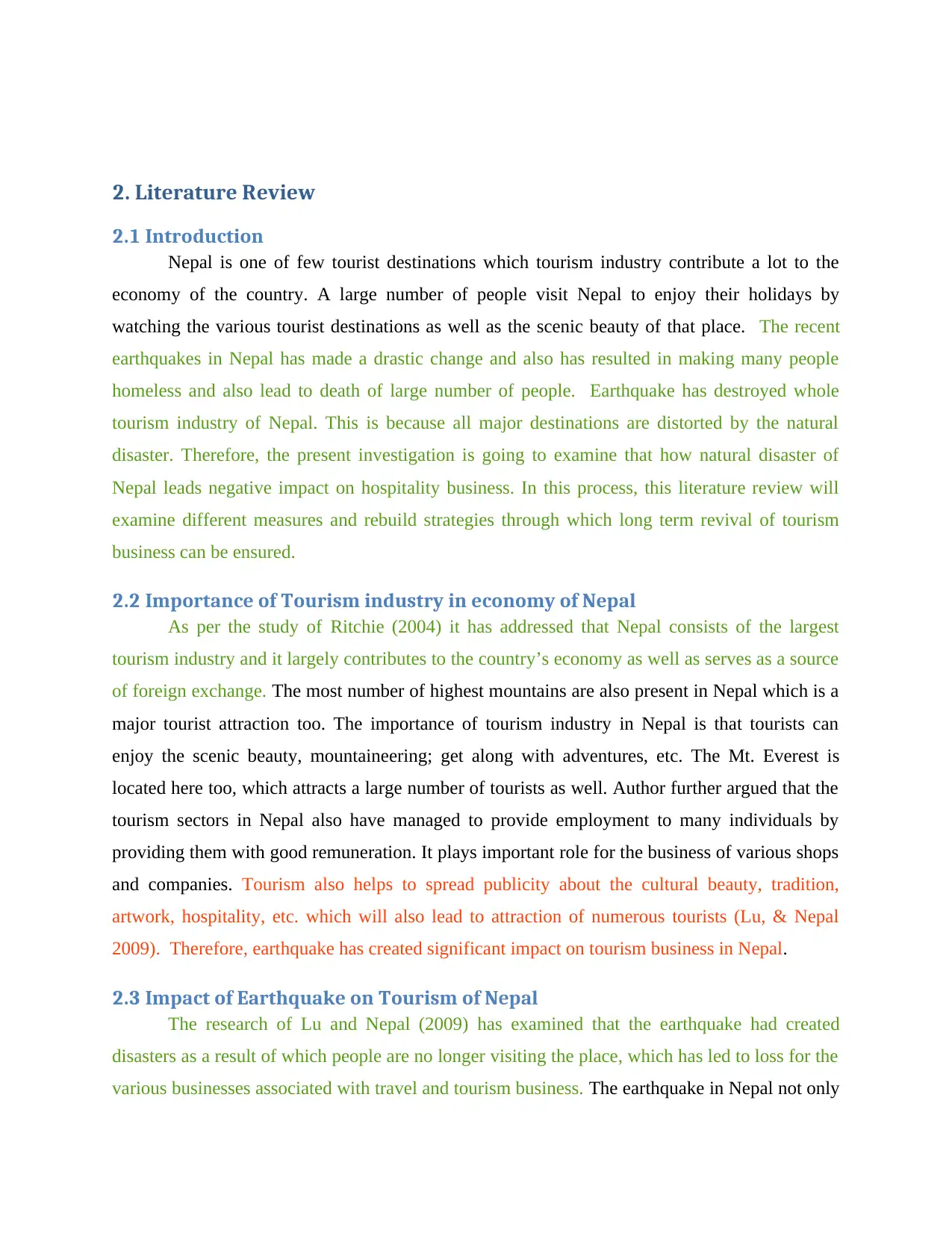
2. Literature Review
2.1 Introduction
Nepal is one of few tourist destinations which tourism industry contribute a lot to the
economy of the country. A large number of people visit Nepal to enjoy their holidays by
watching the various tourist destinations as well as the scenic beauty of that place. The recent
earthquakes in Nepal has made a drastic change and also has resulted in making many people
homeless and also lead to death of large number of people. Earthquake has destroyed whole
tourism industry of Nepal. This is because all major destinations are distorted by the natural
disaster. Therefore, the present investigation is going to examine that how natural disaster of
Nepal leads negative impact on hospitality business. In this process, this literature review will
examine different measures and rebuild strategies through which long term revival of tourism
business can be ensured.
2.2 Importance of Tourism industry in economy of Nepal
As per the study of Ritchie (2004) it has addressed that Nepal consists of the largest
tourism industry and it largely contributes to the country’s economy as well as serves as a source
of foreign exchange. The most number of highest mountains are also present in Nepal which is a
major tourist attraction too. The importance of tourism industry in Nepal is that tourists can
enjoy the scenic beauty, mountaineering; get along with adventures, etc. The Mt. Everest is
located here too, which attracts a large number of tourists as well. Author further argued that the
tourism sectors in Nepal also have managed to provide employment to many individuals by
providing them with good remuneration. It plays important role for the business of various shops
and companies. Tourism also helps to spread publicity about the cultural beauty, tradition,
artwork, hospitality, etc. which will also lead to attraction of numerous tourists (Lu, & Nepal
2009). Therefore, earthquake has created significant impact on tourism business in Nepal.
2.3 Impact of Earthquake on Tourism of Nepal
The research of Lu and Nepal (2009) has examined that the earthquake had created
disasters as a result of which people are no longer visiting the place, which has led to loss for the
various businesses associated with travel and tourism business. The earthquake in Nepal not only
2.1 Introduction
Nepal is one of few tourist destinations which tourism industry contribute a lot to the
economy of the country. A large number of people visit Nepal to enjoy their holidays by
watching the various tourist destinations as well as the scenic beauty of that place. The recent
earthquakes in Nepal has made a drastic change and also has resulted in making many people
homeless and also lead to death of large number of people. Earthquake has destroyed whole
tourism industry of Nepal. This is because all major destinations are distorted by the natural
disaster. Therefore, the present investigation is going to examine that how natural disaster of
Nepal leads negative impact on hospitality business. In this process, this literature review will
examine different measures and rebuild strategies through which long term revival of tourism
business can be ensured.
2.2 Importance of Tourism industry in economy of Nepal
As per the study of Ritchie (2004) it has addressed that Nepal consists of the largest
tourism industry and it largely contributes to the country’s economy as well as serves as a source
of foreign exchange. The most number of highest mountains are also present in Nepal which is a
major tourist attraction too. The importance of tourism industry in Nepal is that tourists can
enjoy the scenic beauty, mountaineering; get along with adventures, etc. The Mt. Everest is
located here too, which attracts a large number of tourists as well. Author further argued that the
tourism sectors in Nepal also have managed to provide employment to many individuals by
providing them with good remuneration. It plays important role for the business of various shops
and companies. Tourism also helps to spread publicity about the cultural beauty, tradition,
artwork, hospitality, etc. which will also lead to attraction of numerous tourists (Lu, & Nepal
2009). Therefore, earthquake has created significant impact on tourism business in Nepal.
2.3 Impact of Earthquake on Tourism of Nepal
The research of Lu and Nepal (2009) has examined that the earthquake had created
disasters as a result of which people are no longer visiting the place, which has led to loss for the
various businesses associated with travel and tourism business. The earthquake in Nepal not only
⊘ This is a preview!⊘
Do you want full access?
Subscribe today to unlock all pages.

Trusted by 1+ million students worldwide
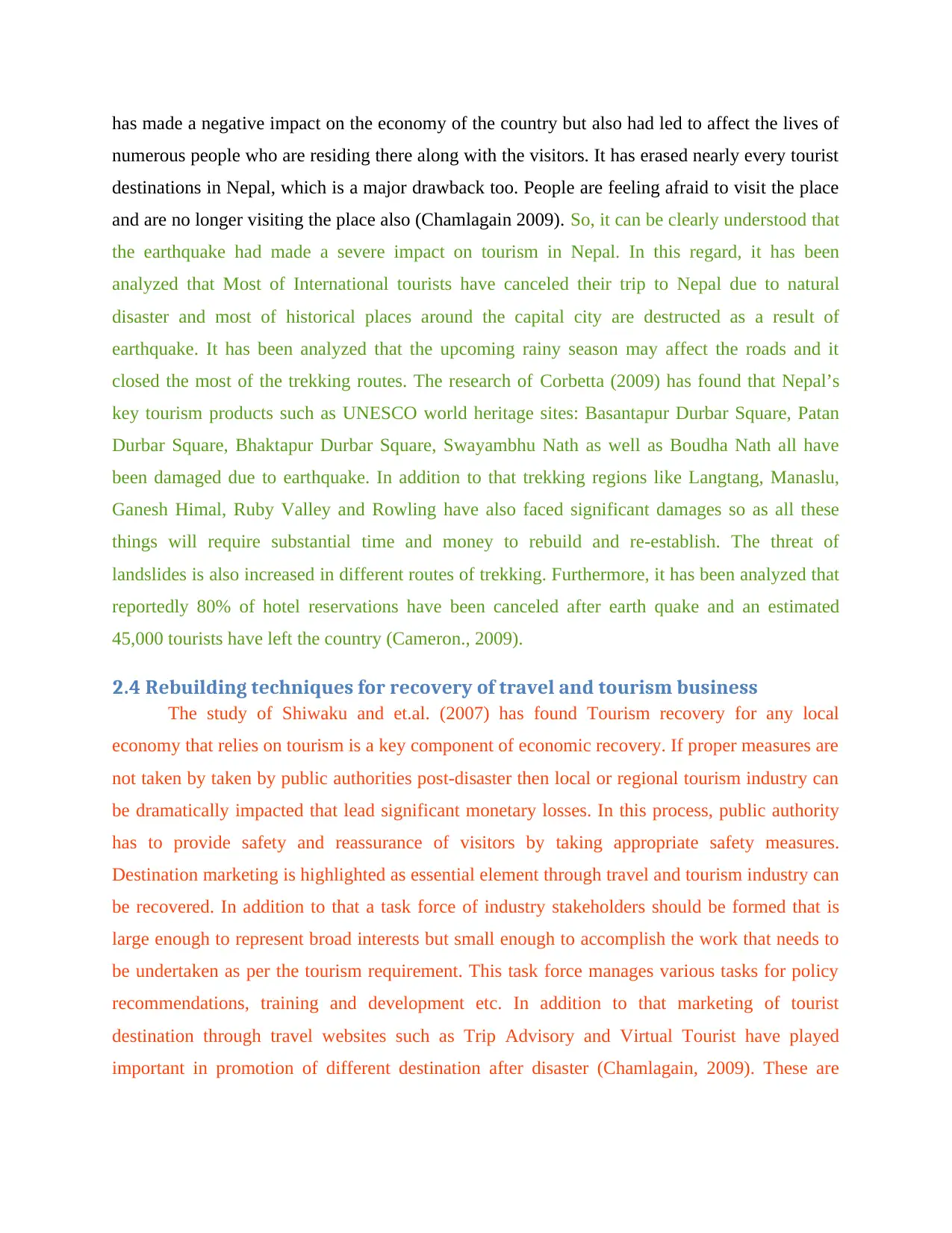
has made a negative impact on the economy of the country but also had led to affect the lives of
numerous people who are residing there along with the visitors. It has erased nearly every tourist
destinations in Nepal, which is a major drawback too. People are feeling afraid to visit the place
and are no longer visiting the place also (Chamlagain 2009). So, it can be clearly understood that
the earthquake had made a severe impact on tourism in Nepal. In this regard, it has been
analyzed that Most of International tourists have canceled their trip to Nepal due to natural
disaster and most of historical places around the capital city are destructed as a result of
earthquake. It has been analyzed that the upcoming rainy season may affect the roads and it
closed the most of the trekking routes. The research of Corbetta (2009) has found that Nepal’s
key tourism products such as UNESCO world heritage sites: Basantapur Durbar Square, Patan
Durbar Square, Bhaktapur Durbar Square, Swayambhu Nath as well as Boudha Nath all have
been damaged due to earthquake. In addition to that trekking regions like Langtang, Manaslu,
Ganesh Himal, Ruby Valley and Rowling have also faced significant damages so as all these
things will require substantial time and money to rebuild and re-establish. The threat of
landslides is also increased in different routes of trekking. Furthermore, it has been analyzed that
reportedly 80% of hotel reservations have been canceled after earth quake and an estimated
45,000 tourists have left the country (Cameron., 2009).
2.4 Rebuilding techniques for recovery of travel and tourism business
The study of Shiwaku and et.al. (2007) has found Tourism recovery for any local
economy that relies on tourism is a key component of economic recovery. If proper measures are
not taken by taken by public authorities post-disaster then local or regional tourism industry can
be dramatically impacted that lead significant monetary losses. In this process, public authority
has to provide safety and reassurance of visitors by taking appropriate safety measures.
Destination marketing is highlighted as essential element through travel and tourism industry can
be recovered. In addition to that a task force of industry stakeholders should be formed that is
large enough to represent broad interests but small enough to accomplish the work that needs to
be undertaken as per the tourism requirement. This task force manages various tasks for policy
recommendations, training and development etc. In addition to that marketing of tourist
destination through travel websites such as Trip Advisory and Virtual Tourist have played
important in promotion of different destination after disaster (Chamlagain, 2009). These are
numerous people who are residing there along with the visitors. It has erased nearly every tourist
destinations in Nepal, which is a major drawback too. People are feeling afraid to visit the place
and are no longer visiting the place also (Chamlagain 2009). So, it can be clearly understood that
the earthquake had made a severe impact on tourism in Nepal. In this regard, it has been
analyzed that Most of International tourists have canceled their trip to Nepal due to natural
disaster and most of historical places around the capital city are destructed as a result of
earthquake. It has been analyzed that the upcoming rainy season may affect the roads and it
closed the most of the trekking routes. The research of Corbetta (2009) has found that Nepal’s
key tourism products such as UNESCO world heritage sites: Basantapur Durbar Square, Patan
Durbar Square, Bhaktapur Durbar Square, Swayambhu Nath as well as Boudha Nath all have
been damaged due to earthquake. In addition to that trekking regions like Langtang, Manaslu,
Ganesh Himal, Ruby Valley and Rowling have also faced significant damages so as all these
things will require substantial time and money to rebuild and re-establish. The threat of
landslides is also increased in different routes of trekking. Furthermore, it has been analyzed that
reportedly 80% of hotel reservations have been canceled after earth quake and an estimated
45,000 tourists have left the country (Cameron., 2009).
2.4 Rebuilding techniques for recovery of travel and tourism business
The study of Shiwaku and et.al. (2007) has found Tourism recovery for any local
economy that relies on tourism is a key component of economic recovery. If proper measures are
not taken by taken by public authorities post-disaster then local or regional tourism industry can
be dramatically impacted that lead significant monetary losses. In this process, public authority
has to provide safety and reassurance of visitors by taking appropriate safety measures.
Destination marketing is highlighted as essential element through travel and tourism industry can
be recovered. In addition to that a task force of industry stakeholders should be formed that is
large enough to represent broad interests but small enough to accomplish the work that needs to
be undertaken as per the tourism requirement. This task force manages various tasks for policy
recommendations, training and development etc. In addition to that marketing of tourist
destination through travel websites such as Trip Advisory and Virtual Tourist have played
important in promotion of different destination after disaster (Chamlagain, 2009). These are
Paraphrase This Document
Need a fresh take? Get an instant paraphrase of this document with our AI Paraphraser
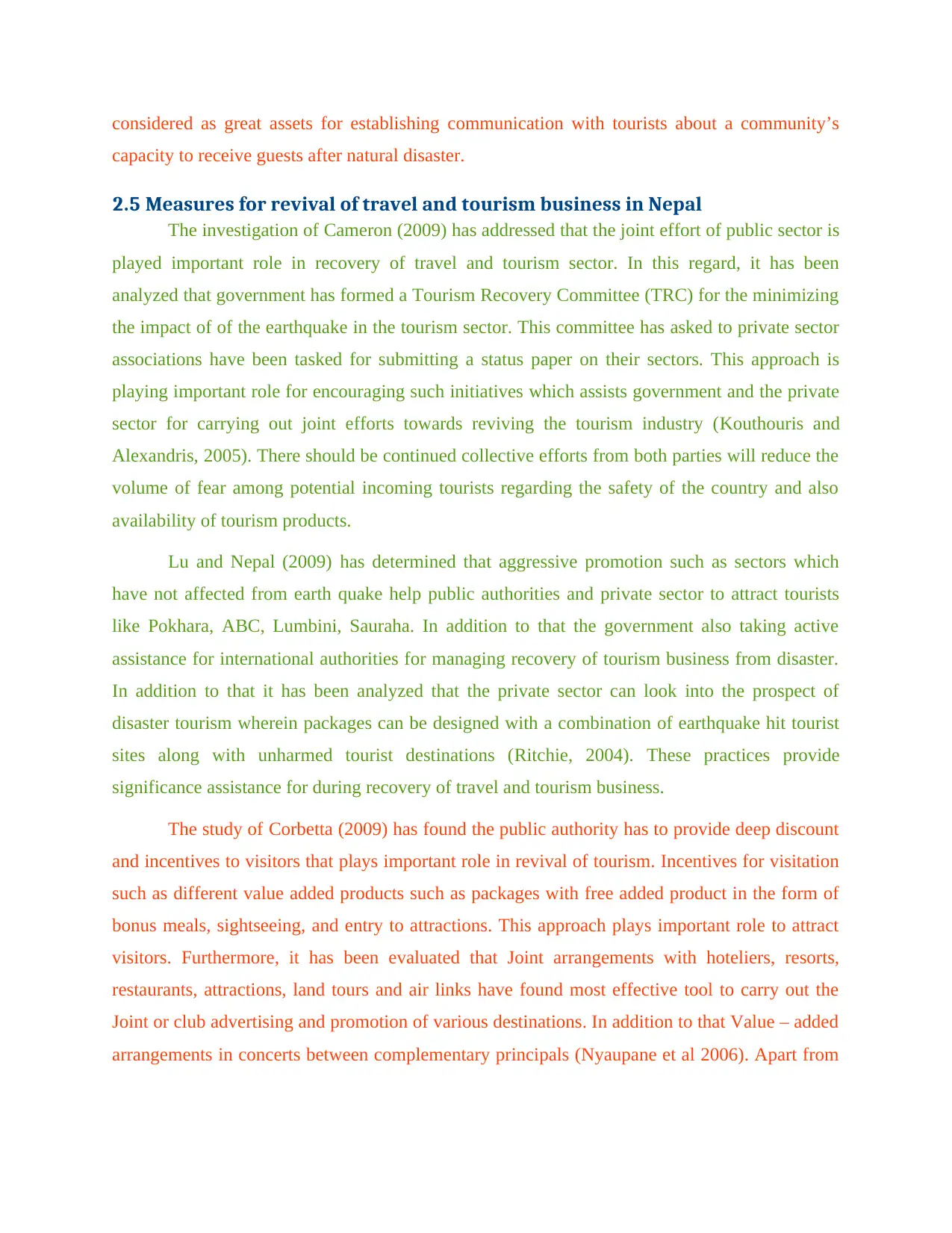
considered as great assets for establishing communication with tourists about a community’s
capacity to receive guests after natural disaster.
2.5 Measures for revival of travel and tourism business in Nepal
The investigation of Cameron (2009) has addressed that the joint effort of public sector is
played important role in recovery of travel and tourism sector. In this regard, it has been
analyzed that government has formed a Tourism Recovery Committee (TRC) for the minimizing
the impact of of the earthquake in the tourism sector. This committee has asked to private sector
associations have been tasked for submitting a status paper on their sectors. This approach is
playing important role for encouraging such initiatives which assists government and the private
sector for carrying out joint efforts towards reviving the tourism industry (Kouthouris and
Alexandris, 2005). There should be continued collective efforts from both parties will reduce the
volume of fear among potential incoming tourists regarding the safety of the country and also
availability of tourism products.
Lu and Nepal (2009) has determined that aggressive promotion such as sectors which
have not affected from earth quake help public authorities and private sector to attract tourists
like Pokhara, ABC, Lumbini, Sauraha. In addition to that the government also taking active
assistance for international authorities for managing recovery of tourism business from disaster.
In addition to that it has been analyzed that the private sector can look into the prospect of
disaster tourism wherein packages can be designed with a combination of earthquake hit tourist
sites along with unharmed tourist destinations (Ritchie, 2004). These practices provide
significance assistance for during recovery of travel and tourism business.
The study of Corbetta (2009) has found the public authority has to provide deep discount
and incentives to visitors that plays important role in revival of tourism. Incentives for visitation
such as different value added products such as packages with free added product in the form of
bonus meals, sightseeing, and entry to attractions. This approach plays important role to attract
visitors. Furthermore, it has been evaluated that Joint arrangements with hoteliers, resorts,
restaurants, attractions, land tours and air links have found most effective tool to carry out the
Joint or club advertising and promotion of various destinations. In addition to that Value – added
arrangements in concerts between complementary principals (Nyaupane et al 2006). Apart from
capacity to receive guests after natural disaster.
2.5 Measures for revival of travel and tourism business in Nepal
The investigation of Cameron (2009) has addressed that the joint effort of public sector is
played important role in recovery of travel and tourism sector. In this regard, it has been
analyzed that government has formed a Tourism Recovery Committee (TRC) for the minimizing
the impact of of the earthquake in the tourism sector. This committee has asked to private sector
associations have been tasked for submitting a status paper on their sectors. This approach is
playing important role for encouraging such initiatives which assists government and the private
sector for carrying out joint efforts towards reviving the tourism industry (Kouthouris and
Alexandris, 2005). There should be continued collective efforts from both parties will reduce the
volume of fear among potential incoming tourists regarding the safety of the country and also
availability of tourism products.
Lu and Nepal (2009) has determined that aggressive promotion such as sectors which
have not affected from earth quake help public authorities and private sector to attract tourists
like Pokhara, ABC, Lumbini, Sauraha. In addition to that the government also taking active
assistance for international authorities for managing recovery of tourism business from disaster.
In addition to that it has been analyzed that the private sector can look into the prospect of
disaster tourism wherein packages can be designed with a combination of earthquake hit tourist
sites along with unharmed tourist destinations (Ritchie, 2004). These practices provide
significance assistance for during recovery of travel and tourism business.
The study of Corbetta (2009) has found the public authority has to provide deep discount
and incentives to visitors that plays important role in revival of tourism. Incentives for visitation
such as different value added products such as packages with free added product in the form of
bonus meals, sightseeing, and entry to attractions. This approach plays important role to attract
visitors. Furthermore, it has been evaluated that Joint arrangements with hoteliers, resorts,
restaurants, attractions, land tours and air links have found most effective tool to carry out the
Joint or club advertising and promotion of various destinations. In addition to that Value – added
arrangements in concerts between complementary principals (Nyaupane et al 2006). Apart from
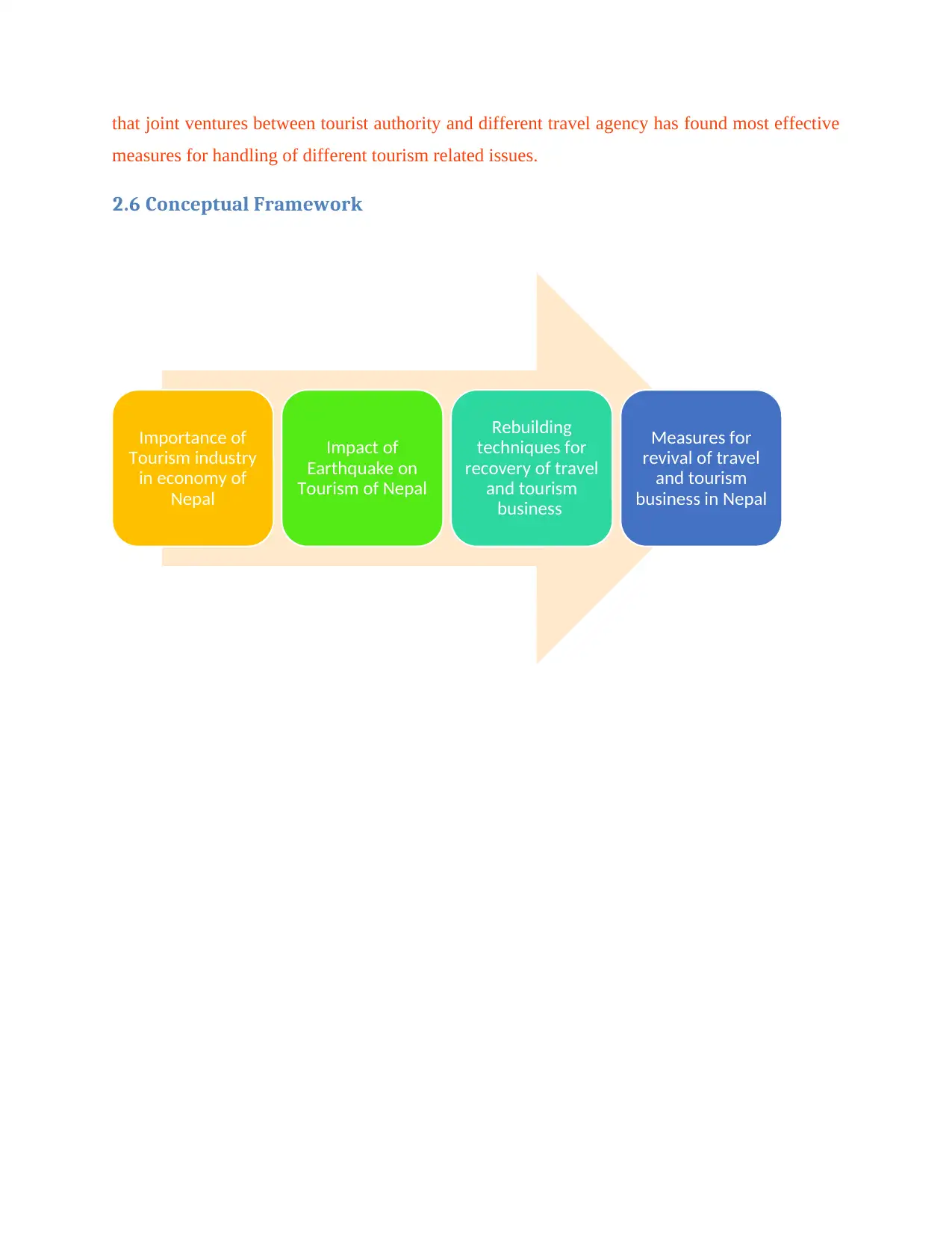
that joint ventures between tourist authority and different travel agency has found most effective
measures for handling of different tourism related issues.
2.6 Conceptual Framework
Importance of
Tourism industry
in economy of
Nepal
Impact of
Earthquake on
Tourism of Nepal
Rebuilding
techniques for
recovery of travel
and tourism
business
Measures for
revival of travel
and tourism
business in Nepal
measures for handling of different tourism related issues.
2.6 Conceptual Framework
Importance of
Tourism industry
in economy of
Nepal
Impact of
Earthquake on
Tourism of Nepal
Rebuilding
techniques for
recovery of travel
and tourism
business
Measures for
revival of travel
and tourism
business in Nepal
⊘ This is a preview!⊘
Do you want full access?
Subscribe today to unlock all pages.

Trusted by 1+ million students worldwide
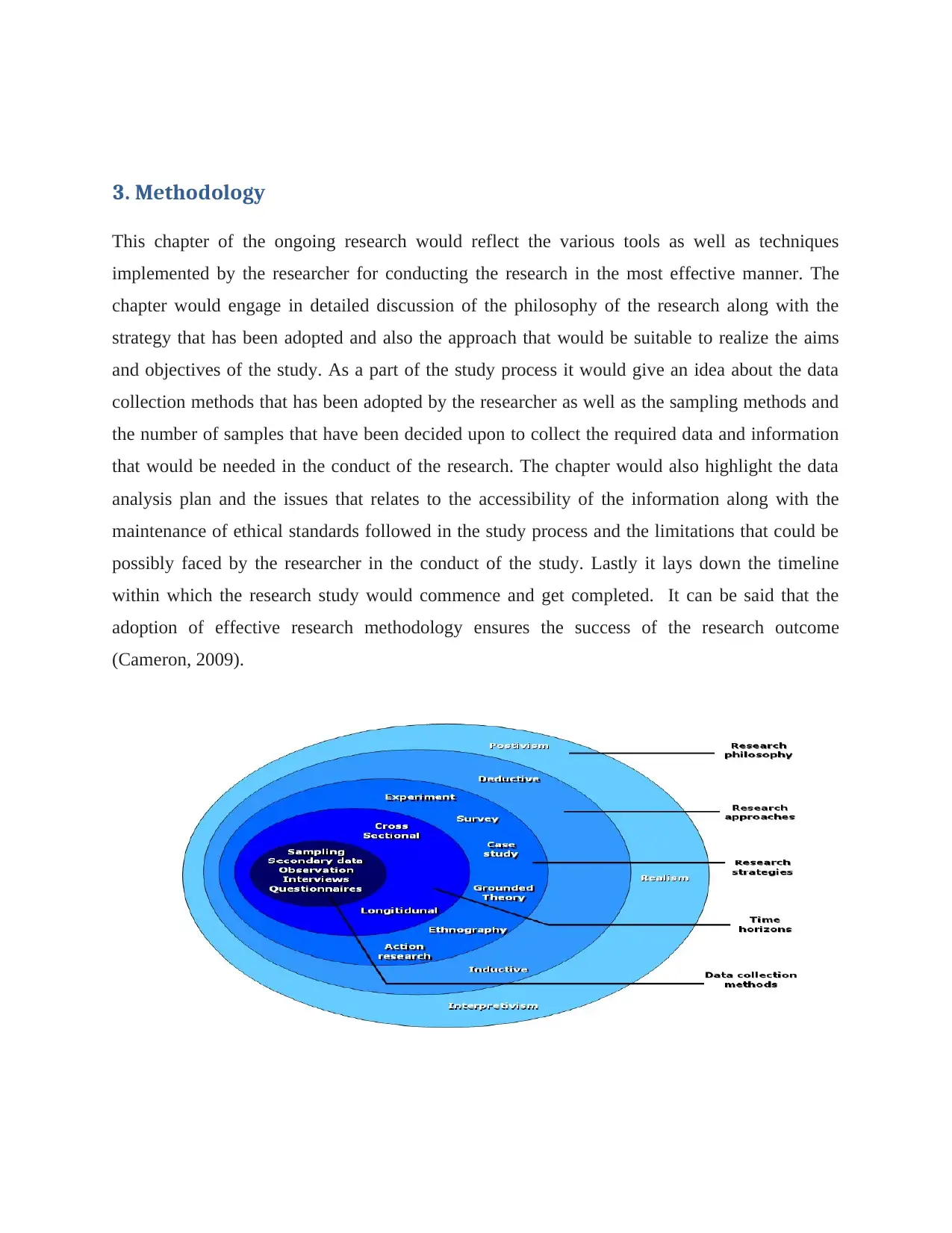
3. Methodology
This chapter of the ongoing research would reflect the various tools as well as techniques
implemented by the researcher for conducting the research in the most effective manner. The
chapter would engage in detailed discussion of the philosophy of the research along with the
strategy that has been adopted and also the approach that would be suitable to realize the aims
and objectives of the study. As a part of the study process it would give an idea about the data
collection methods that has been adopted by the researcher as well as the sampling methods and
the number of samples that have been decided upon to collect the required data and information
that would be needed in the conduct of the research. The chapter would also highlight the data
analysis plan and the issues that relates to the accessibility of the information along with the
maintenance of ethical standards followed in the study process and the limitations that could be
possibly faced by the researcher in the conduct of the study. Lastly it lays down the timeline
within which the research study would commence and get completed. It can be said that the
adoption of effective research methodology ensures the success of the research outcome
(Cameron, 2009).
This chapter of the ongoing research would reflect the various tools as well as techniques
implemented by the researcher for conducting the research in the most effective manner. The
chapter would engage in detailed discussion of the philosophy of the research along with the
strategy that has been adopted and also the approach that would be suitable to realize the aims
and objectives of the study. As a part of the study process it would give an idea about the data
collection methods that has been adopted by the researcher as well as the sampling methods and
the number of samples that have been decided upon to collect the required data and information
that would be needed in the conduct of the research. The chapter would also highlight the data
analysis plan and the issues that relates to the accessibility of the information along with the
maintenance of ethical standards followed in the study process and the limitations that could be
possibly faced by the researcher in the conduct of the study. Lastly it lays down the timeline
within which the research study would commence and get completed. It can be said that the
adoption of effective research methodology ensures the success of the research outcome
(Cameron, 2009).
Paraphrase This Document
Need a fresh take? Get an instant paraphrase of this document with our AI Paraphraser
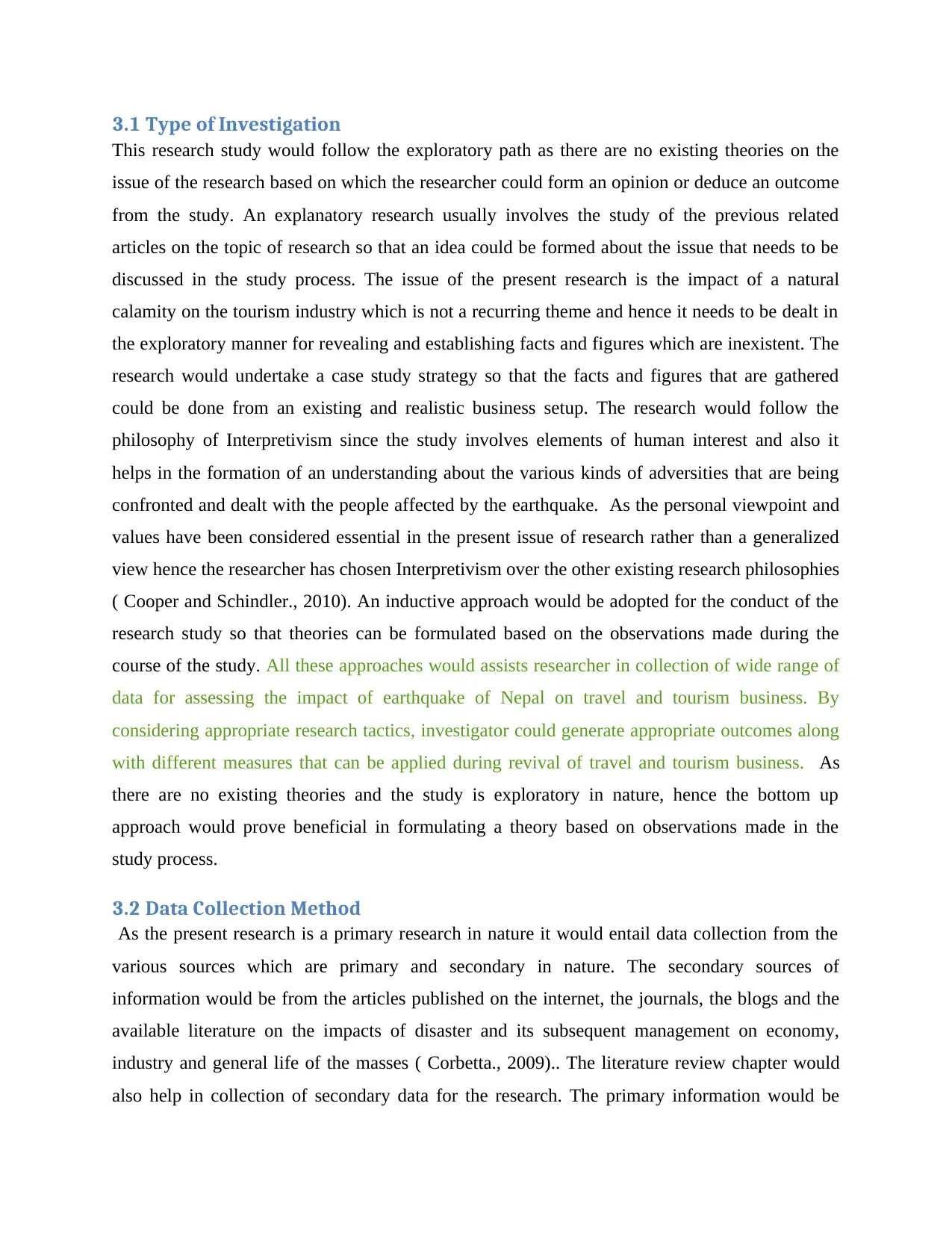
3.1 Type of Investigation
This research study would follow the exploratory path as there are no existing theories on the
issue of the research based on which the researcher could form an opinion or deduce an outcome
from the study. An explanatory research usually involves the study of the previous related
articles on the topic of research so that an idea could be formed about the issue that needs to be
discussed in the study process. The issue of the present research is the impact of a natural
calamity on the tourism industry which is not a recurring theme and hence it needs to be dealt in
the exploratory manner for revealing and establishing facts and figures which are inexistent. The
research would undertake a case study strategy so that the facts and figures that are gathered
could be done from an existing and realistic business setup. The research would follow the
philosophy of Interpretivism since the study involves elements of human interest and also it
helps in the formation of an understanding about the various kinds of adversities that are being
confronted and dealt with the people affected by the earthquake. As the personal viewpoint and
values have been considered essential in the present issue of research rather than a generalized
view hence the researcher has chosen Interpretivism over the other existing research philosophies
( Cooper and Schindler., 2010). An inductive approach would be adopted for the conduct of the
research study so that theories can be formulated based on the observations made during the
course of the study. All these approaches would assists researcher in collection of wide range of
data for assessing the impact of earthquake of Nepal on travel and tourism business. By
considering appropriate research tactics, investigator could generate appropriate outcomes along
with different measures that can be applied during revival of travel and tourism business. As
there are no existing theories and the study is exploratory in nature, hence the bottom up
approach would prove beneficial in formulating a theory based on observations made in the
study process.
3.2 Data Collection Method
As the present research is a primary research in nature it would entail data collection from the
various sources which are primary and secondary in nature. The secondary sources of
information would be from the articles published on the internet, the journals, the blogs and the
available literature on the impacts of disaster and its subsequent management on economy,
industry and general life of the masses ( Corbetta., 2009).. The literature review chapter would
also help in collection of secondary data for the research. The primary information would be
This research study would follow the exploratory path as there are no existing theories on the
issue of the research based on which the researcher could form an opinion or deduce an outcome
from the study. An explanatory research usually involves the study of the previous related
articles on the topic of research so that an idea could be formed about the issue that needs to be
discussed in the study process. The issue of the present research is the impact of a natural
calamity on the tourism industry which is not a recurring theme and hence it needs to be dealt in
the exploratory manner for revealing and establishing facts and figures which are inexistent. The
research would undertake a case study strategy so that the facts and figures that are gathered
could be done from an existing and realistic business setup. The research would follow the
philosophy of Interpretivism since the study involves elements of human interest and also it
helps in the formation of an understanding about the various kinds of adversities that are being
confronted and dealt with the people affected by the earthquake. As the personal viewpoint and
values have been considered essential in the present issue of research rather than a generalized
view hence the researcher has chosen Interpretivism over the other existing research philosophies
( Cooper and Schindler., 2010). An inductive approach would be adopted for the conduct of the
research study so that theories can be formulated based on the observations made during the
course of the study. All these approaches would assists researcher in collection of wide range of
data for assessing the impact of earthquake of Nepal on travel and tourism business. By
considering appropriate research tactics, investigator could generate appropriate outcomes along
with different measures that can be applied during revival of travel and tourism business. As
there are no existing theories and the study is exploratory in nature, hence the bottom up
approach would prove beneficial in formulating a theory based on observations made in the
study process.
3.2 Data Collection Method
As the present research is a primary research in nature it would entail data collection from the
various sources which are primary and secondary in nature. The secondary sources of
information would be from the articles published on the internet, the journals, the blogs and the
available literature on the impacts of disaster and its subsequent management on economy,
industry and general life of the masses ( Corbetta., 2009).. The literature review chapter would
also help in collection of secondary data for the research. The primary information would be
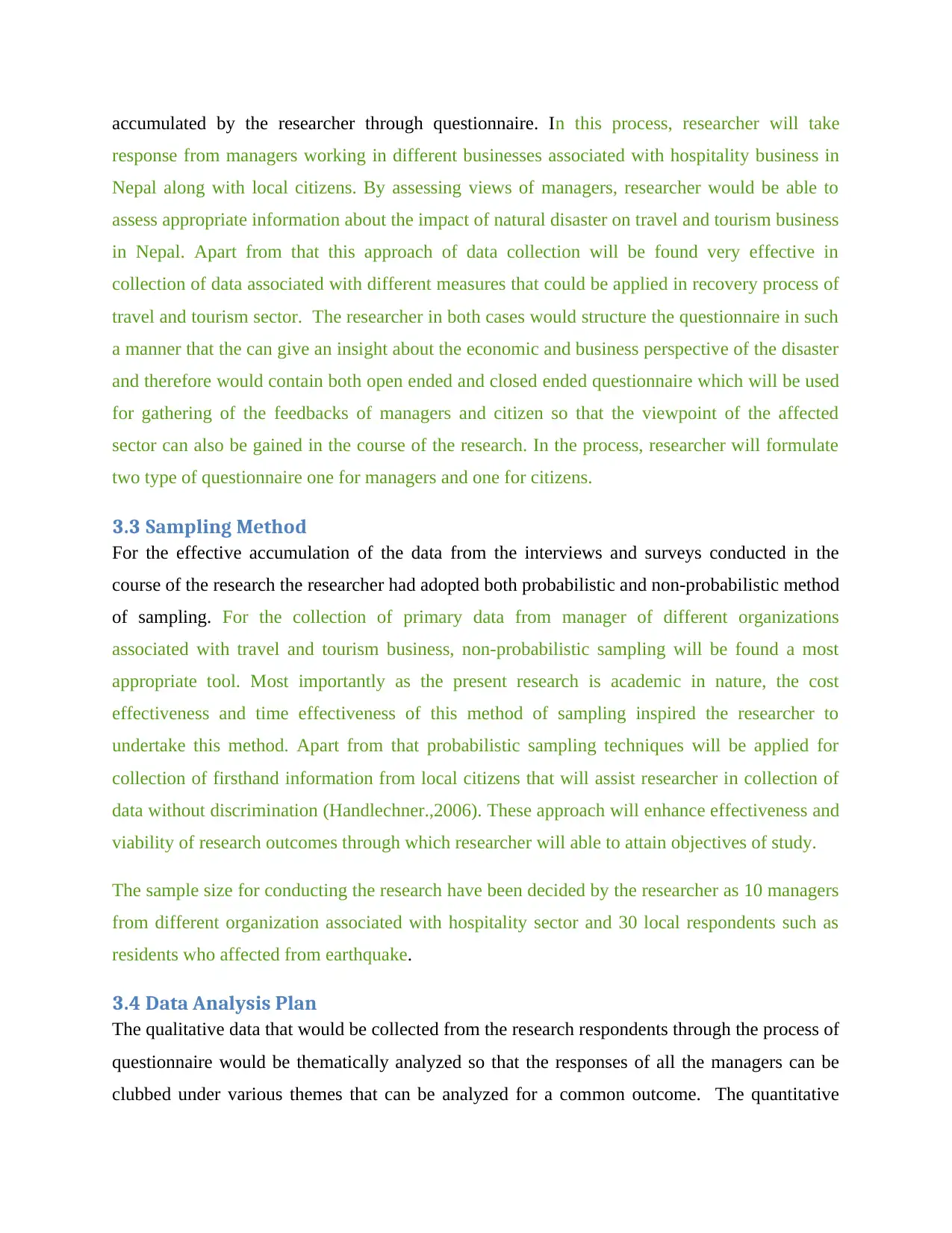
accumulated by the researcher through questionnaire. In this process, researcher will take
response from managers working in different businesses associated with hospitality business in
Nepal along with local citizens. By assessing views of managers, researcher would be able to
assess appropriate information about the impact of natural disaster on travel and tourism business
in Nepal. Apart from that this approach of data collection will be found very effective in
collection of data associated with different measures that could be applied in recovery process of
travel and tourism sector. The researcher in both cases would structure the questionnaire in such
a manner that the can give an insight about the economic and business perspective of the disaster
and therefore would contain both open ended and closed ended questionnaire which will be used
for gathering of the feedbacks of managers and citizen so that the viewpoint of the affected
sector can also be gained in the course of the research. In the process, researcher will formulate
two type of questionnaire one for managers and one for citizens.
3.3 Sampling Method
For the effective accumulation of the data from the interviews and surveys conducted in the
course of the research the researcher had adopted both probabilistic and non-probabilistic method
of sampling. For the collection of primary data from manager of different organizations
associated with travel and tourism business, non-probabilistic sampling will be found a most
appropriate tool. Most importantly as the present research is academic in nature, the cost
effectiveness and time effectiveness of this method of sampling inspired the researcher to
undertake this method. Apart from that probabilistic sampling techniques will be applied for
collection of firsthand information from local citizens that will assist researcher in collection of
data without discrimination (Handlechner.,2006). These approach will enhance effectiveness and
viability of research outcomes through which researcher will able to attain objectives of study.
The sample size for conducting the research have been decided by the researcher as 10 managers
from different organization associated with hospitality sector and 30 local respondents such as
residents who affected from earthquake.
3.4 Data Analysis Plan
The qualitative data that would be collected from the research respondents through the process of
questionnaire would be thematically analyzed so that the responses of all the managers can be
clubbed under various themes that can be analyzed for a common outcome. The quantitative
response from managers working in different businesses associated with hospitality business in
Nepal along with local citizens. By assessing views of managers, researcher would be able to
assess appropriate information about the impact of natural disaster on travel and tourism business
in Nepal. Apart from that this approach of data collection will be found very effective in
collection of data associated with different measures that could be applied in recovery process of
travel and tourism sector. The researcher in both cases would structure the questionnaire in such
a manner that the can give an insight about the economic and business perspective of the disaster
and therefore would contain both open ended and closed ended questionnaire which will be used
for gathering of the feedbacks of managers and citizen so that the viewpoint of the affected
sector can also be gained in the course of the research. In the process, researcher will formulate
two type of questionnaire one for managers and one for citizens.
3.3 Sampling Method
For the effective accumulation of the data from the interviews and surveys conducted in the
course of the research the researcher had adopted both probabilistic and non-probabilistic method
of sampling. For the collection of primary data from manager of different organizations
associated with travel and tourism business, non-probabilistic sampling will be found a most
appropriate tool. Most importantly as the present research is academic in nature, the cost
effectiveness and time effectiveness of this method of sampling inspired the researcher to
undertake this method. Apart from that probabilistic sampling techniques will be applied for
collection of firsthand information from local citizens that will assist researcher in collection of
data without discrimination (Handlechner.,2006). These approach will enhance effectiveness and
viability of research outcomes through which researcher will able to attain objectives of study.
The sample size for conducting the research have been decided by the researcher as 10 managers
from different organization associated with hospitality sector and 30 local respondents such as
residents who affected from earthquake.
3.4 Data Analysis Plan
The qualitative data that would be collected from the research respondents through the process of
questionnaire would be thematically analyzed so that the responses of all the managers can be
clubbed under various themes that can be analyzed for a common outcome. The quantitative
⊘ This is a preview!⊘
Do you want full access?
Subscribe today to unlock all pages.

Trusted by 1+ million students worldwide
1 out of 18
Your All-in-One AI-Powered Toolkit for Academic Success.
+13062052269
info@desklib.com
Available 24*7 on WhatsApp / Email
![[object Object]](/_next/static/media/star-bottom.7253800d.svg)
Unlock your academic potential
Copyright © 2020–2025 A2Z Services. All Rights Reserved. Developed and managed by ZUCOL.
